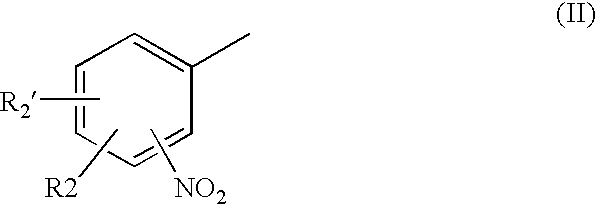Compositions and methods for dyeing keratinous fibers
- Summary
- Abstract
- Description
- Claims
- Application Information
AI Technical Summary
Problems solved by technology
Method used
Image
Examples
example 1
Preparation of 5-[5-amino-6-nitro-2-(pyridinyl)amino]-5-oxopentanoic acid (=glutaramide of 2,5-diamino-6-nitropyridine)
[0066]To a mixture of 3.08 g (20 mmol) of 2,5-diamino-6-nitropyridine and 0.36 g (3 mmol) of N,N-dimethylamino-pyridine in 120 ml of tetrahydrofurane, 5.7 g (50 mmol) of glutaric anhydride were added at room temperature. The mixture was stirred for 3 hours at room temperature and then refluxed for additional 3 hours. The mixture was then filtered, the solvent was evaporated and the crude product was dissolved in ethylacetate and extracted three times with a 1N sodium hydroxide solution. The combined aqueous extracts were acidified with conc. HCI at 0° C. A precipitate was formed, and filtration yielded an orange solid. The solid so obtained was washed with water. After drying 4.33 g (81% yield) of 5-[5-amino-6-nitro-2-pyridinyl)amino]-5-oxopentanoic acid were obtained.
example 2
Preparation of 5-[(6-amino-5-(3-pyridinyidiazenyl)-2-pyridinyl)amino]-5-oxopentanoic acid (=glutaramide of 2,6-diamino-3-((pyridin-3-yl)azo)pyridine)
[0067]To a mixture of 3.21 g (15 mmol) of 2,6-diamino-3-((pyridin-3-yl)azo)pyridine and 0.27 g (2.2 mmol) of N,N-dimethylamino-pyridine in 100 ml of tetrahydrofurane, 4.27 g (37.5 mmol) of glutaric anhydride was added at room temperature. The mixture was refluxed for 16 hours. The mixture was then filtered, the solvent was evaporated and the crude product was dissolved in ethylacetate and extracted three times with a 1N sodium hydroxide solution. The combined aqueous extracts were acidified with conc. HCI at 0° C. A precipitate was formed, and filtration yielded an orange solid. The solid so obtained was washed with water. After drying the product was recristallised in methanol / water mixture and 1.9 g (40% yield) of 5-[(6-amino-5-(3-pyridinyldiazenyl)-2-pyridinyl)amino]-5-oxopentanoic acid were obtained.
examples 3 – 45
Examples 3–45
Preparation of Glutaramides of Alternative Amine-containing Direct Dyes to Produce Pro-dyes
[0068]Procedures analogous to those used in Example 1 or Example 2 can be repeated with minor modifications to produce mono-glutaramide or di-glutaramide pro-dyes from the following 43 amine-containing direct dyes:[0069]3. 1-Amino-3-methyl-4-[(2-hydroxyethyl)amino]-6-nitrobenzene (HC Violet No. 1),[0070]4. 2-((4-Amino-2-nitrophenyl)amino)-5-dimethylamino-benzoic acid (HC Blue No. 13),[0071]5. 1-Amino-4-[(2-hydroxyethyl)amino]-2-nitrobenzene (HC Red No. 7),[0072]6. 2-Amino-4,6-dinitro-phenol,[0073]7. 1,4-Diamino-2-nitrobenzene (CI76070),[0074]8. 4-Amino-2-nitrodiphenylamine (HC Red No. 1),[0075]9. 1-Amino-4-[di(2-hydroxyethyl)amino]-2-nitrobenzene-hydrochloride (HC Red No. 13),[0076]10. 1-Amino-5-chloro-4-[(2-hydroxyethyl)amino]-2-nitrobenzene,[0077]11. 4-Amino-1-[(2-hydroxyethyl)amino]-2-nitrobenzene (HC Red No. 3),[0078]12. 1-Amino-4-((2,3-dihydroxypropyl)amino)-5-methyl-2-nitrob...
PUM
| Property | Measurement | Unit |
|---|---|---|
| Percent by mass | aaaaa | aaaaa |
| Percent by mass | aaaaa | aaaaa |
| Weight | aaaaa | aaaaa |
Abstract
Description
Claims
Application Information
 Login to view more
Login to view more - R&D Engineer
- R&D Manager
- IP Professional
- Industry Leading Data Capabilities
- Powerful AI technology
- Patent DNA Extraction
Browse by: Latest US Patents, China's latest patents, Technical Efficacy Thesaurus, Application Domain, Technology Topic.
© 2024 PatSnap. All rights reserved.Legal|Privacy policy|Modern Slavery Act Transparency Statement|Sitemap



